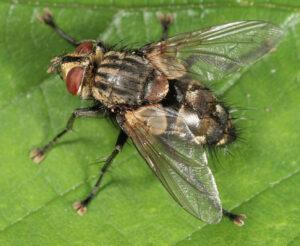Tachinid Fly (Tachinidae)
Updated on
17/11/2022Tachinid flies or tachinids are true flies that constitute the family Tachinidae. It has more than 82000 species, with many more yet to be discovered. They are mainly protelean parasitoids (parasites that kill their hosts completely in the early stages of their life to emerge as free adults), with a few being parasites of arthropods, especially insects.
Their natural predation of primary insect pests has made them extremely important in biological pest control. Conversely, their preying on beneficial insects like silkworm larvae has also led them to be considered as pests themselves.
Scientific Classification
- Class:Insecta
- Order:Diptera
- Section:Schizophora
- Subsection:Calyptratae
- Superfamily:Oestroidea
- Family:Tachinidae
Conservation Status
Description
Their appearance varies a lot among different species. Some may be brightly colored, resembling blowflies, while most are dull colored, resembling houseflies. But tachinids are more robust and bristly. Their antennae have 3 segments and a prominent postscutellum (a flap-like plate) bulging below, on either side of the scutellum. Their arista are usually bare but can be plumose at times. Their calypters (small flaps over the halteres) are very big, with their 4th long vein bending very sharply.
Distribution: All over the world, with special diversity in South America.
Habitat: All over the garden and landscape.
Do They Bite/Sting: No.
Lifespan: 3-4 weeks.
Predators: Insectivorous bats.
Behavior and Characteristics
Diet
The adults derive their nutrition from decaying matter, flowers, and nectar collected from scale insects and aphids. They are not parasitic. Some pollen-feeding species act as important pollinators of some plants, especially those at high altitudes where bees are few.
The larvae feed on host tissues. Typically, they are endoparasites (internal parasites) of caterpillars of moths and butterflies or sawfly larvae. Some species attack beetles and their larvae, some others parasitize various true bugs, some attack grasshoppers, and a few feed on centipedes. Sawflies, bees, and wasps are also parasitized.
Life Cycle
1. Egg Stage
Different species have different methods of oviposition and host invasion. Most female flies lay white, ovoid eggs with flat lower sides on the hosts’ skin (species in the genera Gymnosoma, Winthemia, Eutachina, and Thrixion). Others deposit a hatching larva on the host (species in the genera Voria, and Exorista). Many others inject the eggs into the host (genera Alophora, Ocyptera, and Compsilura are examples). In another oviposition strategy, large numbers of small, dark eggs are laid on the food plants of the hosts (Sturmia, Gonia, and Zenillia genera are examples). Some genera lay eggs in the host’s environment. Larvae of some genera use an ambush technique to attack and dig into the host.
If only one egg is laid on a single host, it is large and clearly visible. It is so firmly glued to the host’s skin that it cannot be removed without killing it. Their eggs hatch quickly as they are partly developed within the mother’s uterus, which is long and often coiled for housing the developing eggs.
2. Larva Stage
The larvae (maggots) are injected into the host by the parent or penetrate the host from outside. The firm attachment of the eggs to the host’s skin helps the larvae burrow inside the body of the host. They may leave the host to pupate.
2. Pupa Stage
The pupation occurs 4-14 days after the deposition of eggs. It lasts for 1-2 weeks. The pupae are mostly oblong and dark-reddish in color.
3. Adult Stage
The adults are 1/3”-3/4” long. Their body shape, color, and texture vary a lot between species. They complete one to several generations in a year.
Getting Rid of Tachinid Flies
Controlling tachinid flies is especially important to people who don’t want their monarch butterfly caterpillars to be killed by the fly larvae. So they must keep the enclosures of the butterflies screened with the doors never left open. They should raise the monarchs only from eggs or 1st instars and collect all the caterpillars from the garden, especially those in the last instars. Any milkweed cuttings or leaves brought into the cages should be carefully washed to prevent tachinids.
Comparison with Similar Species
Houseflies
Houseflies differ from tachinid flies in color, shape, and size and don’t feed on nectar, unlike the latter.
Source
eol.org, diptera.myspecies.info, gardeningknowhow.com, bugguide.net, projectnoah.org,














